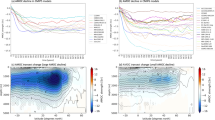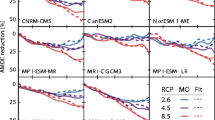Abstract
We present results from detailed interviews with 12 leading climate scientists about the possible effects of global climate change on the Atlantic Meridional Overturning Circulation (AMOC). The elicitation sought to examine the range of opinions within the climatic research community about the physical processes that determine the current strength of the AMOC, its future evolution in a changing climate and the consequences of potential AMOC changes. Experts assign different relative importance to physical processes which determine the present-day strength of the AMOC as well as to forcing factors which determine its future evolution under climate change. Many processes and factors deemed important are assessed as poorly known and insufficiently represented in state-of-the-art climate models. All experts anticipate a weakening of the AMOC under scenarios of increase of greenhouse gas concentrations. Two experts expect a permanent collapse of the AMOC as the most likely response under a 4×CO2 scenario. Assuming a global mean temperature increase in the year 2100 of 4 K, eight experts assess the probability of triggering an AMOC collapse as significantly different from zero, three of them as larger than 40%. Elicited consequences of AMOC reduction include strong changes in temperature, precipitation distribution and sea level in the North Atlantic area. It is expected that an appropriately designed research program, with emphasis on long-term observations and coupled climate modeling, would contribute to substantially reduce uncertainty about the future evolution of the AMOC.
Similar content being viewed by others
Abbreviations
- AMOC:
-
Atlantic meridional overturning circulation
- NADW:
-
North Atlantic deep water
References
Broecker W (1991) The great ocean conveyor. Oceanograhy 4:79–89
Bryden HL, Longworth HR, Cunningham SA (2005) Slowing of the Atlantic meridional overturning circulation at 25°N. Nature 438:655–657, doi:10.1038/nature04385
Budnitz RJ, Apostolakis G, Boore DM, Cluff LS, Coppersmith KJ, Cornell CA, Morris PA (1995) Use of technical expert panels: Applications to probabilistic seismic hazard analysis, Risk Analysis 18(4):463–469
Curry R, Dickson B, Yashayaev I (2003) A change in the freshwater balance of the Atlantic Ocean over the past four decades. Nature 426:826–829
Curry R, Mauritzen C (2005) Dilution of the northern North Atlantic Ocean in recent decades. Science 308:1772–1774
Dalkey NC (1969) The use of self-ratings to improve group estimates. Technol Forecast 12:283–229
Dansgaard W, Johnsen SJ, Clausen HB, Dahl-Jensen NS, Gundestrup NS, Hammer CU, Hvidberg CS, Steffensen JP, Sveinbjoernsdottir AE, Jouzel J, Bond G (1993) Evidence for general instability of past climate from a 250-kyr ice-core record. Nature 364:218–220
Dawes RM (1988) Rational choice in an uncertain world. Harcourt Brace Jovanovich, Orlando, FL
Dickson B, Yashayaev I, Meincke J, Turrell B, Dye S, Holfort J (2002) Rapid freshening of the deep North Atlantic Ocean over the past four decades. Nature 416:832–837
Dickson RR, Lazier J, Meincke J, Rhines P, Swift J (1996) Long-term coordinated changes in the convective activity of the North Atlantic. Prog Oceanogr 38:241–295
Ganachaud A, Wunsch C (2000) Improved estimates of global ocean circulation, heat transport and mixing from hydrographic data. Nature 408:453–457
Goosse H, Renssen H, Selten FM, Haarsma RJ, Opsteegh JD (2002) Potential causes of abrupt climate events: a numerical study with a three-dimensional climate model. Geophys Res Lett 29(18):1860, doi:10.1029/2002GL014993
Gregory J, Dixon K, Stouffer R, Weaver A, Driesschaert E, Eby M, Fichefet T, Hasumi H, Hu A, Jungclaus J, Kamenkovich I, Levermann A, Montoya M, Murakami S, Nawrath S, Oka A, Sokolov A, Thorpe R (2005) A model intercomparison of changes in the Atlantic thermohaline circulation in response to increasing atmospheric CO2 concentration. Geophys Res Lett 32:L12703.1–L12703.5, doi:10.1029/2005GL023209
Gregory J, Huybrechts P, Raper S (2004) Threatened loss of the Greenland ice-sheet. Nature 428:616
Häkkinen S, Rhines P (2004) Decline of subpolar North Atlantic circulation during the 1990s. Science 304:555–559
Hátún H, Sandø AB, Drange H, Hansen B, Valdimarsson H (2005) Influence of the Atlantic subpolar gyre on the thermohaline circulation. Science 309:1841–1844
Houghton J, Ding Y, Griggs D, Noguer M, van der Linden P, Dai X, Maskell K, Johnson C (eds) (2001) Climate change 2001: Scientific basis. Contribution of Working Group I to the Third Assessment Report of the Intergovernmental Panel on Climate Change. Cambridge University Press, Cambridge, UK
Joughin I, Abdalati W, Fahnestock M (2004) Large fluctuations in speed on Greenland’s Jakobshavn Isbræ glacier. Nature 432:608–610
Kahneman D, Slovic P, Tversky A (eds) (1982) Judgments under uncertainty: Heuristics and biases. Cambridge University Press, Camridge, UK
Keith DW (1996) When is it appropriate to combine expert judgments? Clim Change 33:139–143
Knutti R, Flüćkiger J, Stocker T, Timmermann A (2004) Strong hemispheric coupling of glacial climate through freshwater discharge and ocean circulation. Nature 430:851–856
Kuhlbrodt T, Griesel A, Montoya M, Levermann A, Hofmann M, Rahmstorf S (2007) On the driving processes of the Atlantic meridional overturning circulation. Reviews of Geophysics (in press)
Latif M, Röckner E, Mikolajewicz U, Voss R (2000) Tropical stabilization of the thermohaline circulation in a greenhouse warming simulation. J Climate 13:1809–1813
Levermann A, Griesel A, Hofmann M, Montoya M, Rahmstorf S (2005) Dynamic sea level changes following changes in the thermohaline circulation. Clim Dyn 24:347–354
Linstone H, Turoff M (1975) The Delphi Method: Techniques and applications. Addison-Wesley, Reading, MA
Manabe S, Stouffer R (1988) Two stable equilibria of a coupled ocean-atmosphere model. J Climate 1:841–866
Manabe S, Stouffer R (1994) Multiple-century response of a coupled ocean-atmosphere mocel to an increase of atmospheric carbon dioxide. J Climate 7:5–23
McManus J, Francois R, Gherardi J-M, Keigwin L, Brown-Leger S (2004) Collapse and rapid resumption of Atlantic meridional circulation linked to deglacial climate changes. Nature 428:834–837
Morgan MG, Adams PJ, Keith DW (2006) Elicitation of expert judgments of aerosol forcing. Clim Change 75:195–214
Morgan MG, Henrion M (1990) Uncertainty: A guide to dealing with uncertainty in quantitative risk and policy analysis. Cambridge University Press, New York
Morgan MG, Keith D (1995) Subjective judgments by climate experts. Environ Sci Technol 29(10):468–476
Morgan MG, Pitelka LF, Shevliakova E (2001) Elicitation of expert judgments of climate change impacts on forest ecosystems. Clim Change 49:279–307
Moss R, Schneider SH (2000) Uncertainties. In: Pachauri R, Taniguchi R, Tanaka K (eds) Guidance Papers on the Cross Cutting Issues of the Third Assessment Report of the IPCC. World Meteorological Organisation, Geneva, Switzerland
Munk W, Wunsch C (1998) Abyssal recipes II. Deep-Sea Res, Part I 45:1977–2010
Petoukhov V, Claussen M, Berger A, Crucifix M, Eby M, Eliseev A, Fichefet T, Ganopolski A, Goose H, Kamenkovich I, Mokhov I, Montoya M, Mysak L, Sokolov A, Stone P, Wang Z, Weaver A (2005) EMIC Intercomparison Project (EMIP-CO2): Comparative analysis of EMIC simulations of climate and of equilibrium and transient responses to atmospheric CO2 doubling. Clim Dyn 25(4):363–385, doi:10.1007/s00382-005-0042-3
Rahmstorf S (1996) On the freshwater forcing and transport of the Atlantic thermohaline circulation. Clim Dyn 12:799–811
Rahmstorf S (1997) Risk of sea-change in the Atlantic. Nature 388:825–826
Rahmstorf S, Crucifix M, Ganopolski A, Goosse H, Kamenkovich I, Knutti R, Lohmann G, Marsh R, Mysak LA, Wang Z, Weaver AJ (2005) Thermohaline circulation hysteresis: a model intercomparison. Geophys Res Lett 32:L23605, doi:10.1029/2005GL023655
Schaeffer M, Selten FM, Opsteegh JD, Goosse H (2002) Intrinsic limits to predictability of abrupt regional climate change in IPCC SRES scenarios. Geophys Res Lett 29(16), doi:10.1029/2002GL015254
Spetzler CS, Stal von Holstein CAS (1975) Probability encoding in decision analysis. Manage Sci 22:340–352
Stocker T (1998) The seesaw effect. Science 282:61–62
Stommel H (1961) Thermohaline convection with two stable regimes of flow. Tellus 13:224–230
Stouffer R, Yin J, Gregory J, Dixon K, Spelman M, Hurlin W, Weaver A, Eby M, Flato G, Hasumi H, Hu A, Jungclaus J, Kamenkovich I, Levermann A, Montoya M, Murakami S, Nawrath S, Oka A, Peltier W, Robitaille D, Sokolov A, Vettoretti G, Weber S (2006) Investigating the causes of the response of the Thermohaline Circulation to past and future climate changes. J Climate 19:1365–1387
Talley L, Reid J, Robbins P (2003) Data-based meridional overturning streamfunctions for the global ocean. J Climate 16:3213–3226
Toggweiler J, Samuels B (1993) Is the magnitude of the deep outflow from the Atlantic Ocean actually governed by southern hemisphere winds? In: The Global Carbon Cycle. Springer, Berlin
Toggweiler J, Samuels B (1995) Effect of drake passage on the global thermohaline circulation. Deep-Sea Res, Part I 42:477–500
Trenberth K, Caron J (2001) Estimates of meridional atmosphere and ocean heat transport. Clim Dyn 14:3433–3443
Vellinga M, Wood R (2002) Global climatic impacts of a collapse of the Atlantic thermohaline circulation. Clim Change 54:251–267
Winton M (2003) On the climatic impact of ocean circulation. J Climate 16:2875–2889
Wood RA, Keen AB, Mitchell JFB, Gregory JM (1999) Changing spatial structure of the thermohaline circulation in response to atmospheric CO2 forcing in a climate model. Nature 399:572–575
Wu P, Wood R, Stott P (2004) Does the recent freshening trend in the North Atlantic indicate a weakening in the thermohaline circulation? Geophys Res Lett 31:L027301, doi:10.1029/2003GL018584
Author information
Authors and Affiliations
Corresponding author
Rights and permissions
About this article
Cite this article
Zickfeld, K., Levermann, A., Morgan, M.G. et al. Expert judgements on the response of the Atlantic meridional overturning circulation to climate change. Climatic Change 82, 235–265 (2007). https://doi.org/10.1007/s10584-007-9246-3
Received:
Accepted:
Published:
Issue Date:
DOI: https://doi.org/10.1007/s10584-007-9246-3




